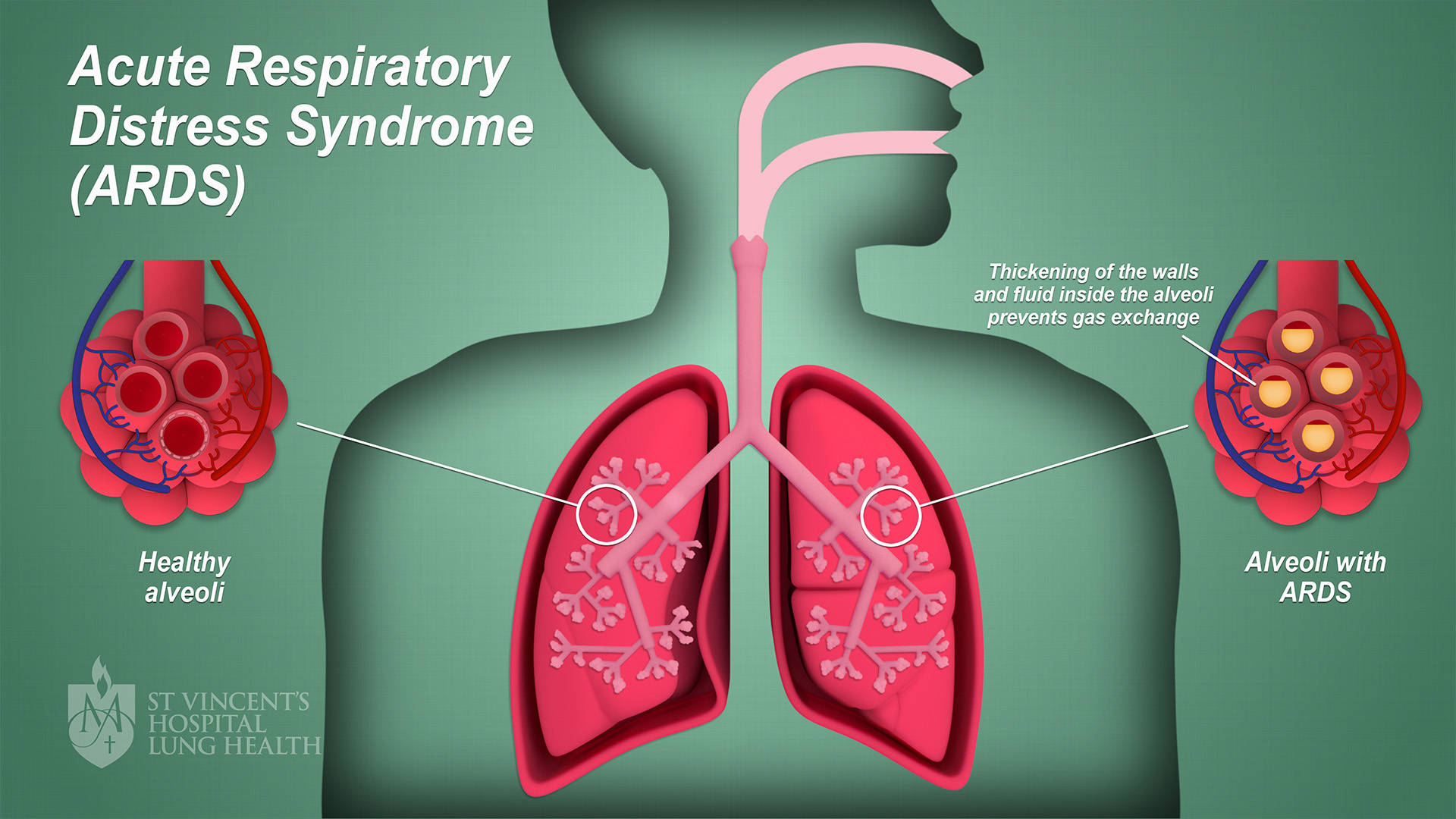ARDS (Acute Respiratory Distress Syndrome)
What is ARDS?
What causes ARDS?
What are the signs and symptoms of ARDS?
What are the possible tests to diagnose ARDS?
What are the possible procedures and treatments for ARDS?
What is the future plan after ARDS?
What is ARDS?
Acute respiratory distress syndrome (ARDS) is a severe condition. Resulting in life threatening impairment of lung function and oxygen levels, ARDS can come on suddenly and progress rapidly. ARDS is a result of fluid build-up in the lung.
The image below illustrates ARDS. (Click image to enlarge)

What causes ARDS?
ARDS can occur in previously healthy people or in patients who have been hospitalised due to severe illness.
ARDS can also result from:
- A variety of different conditions that injure the lung directly,
or
- Secondary to other severe illnesses or trauma.
Some examples of conditions that can result in ARDS include:
- A severe infection of the blood (known as septicaemia)
- An injury to the chest, such as an injury from contact sport, or a car accident
- Breathing in smoke from a house fire or other toxic chemicals
- Developing a severe infection of the lungs, such as pneumonia
- Near-drowning resulting in inhalation of water.
What are the signs and symptoms of ARDS?
The most common symptom of ARDS is sudden and significant difficulty in breathing. Other signs include:
- Blue-tinged lips or nails from lack of oxygen in the blood
- Confusion and dizziness
- Extreme sweating
- Fast and laboured breathing
- General weakness and fatigue
- Low blood pressure.
What are the possible tests to diagnose ARDS?
As there is no one test that can confirm a diagnosis of ARDS, your doctor will take a few different tests.
Tests to diagnose ARDS can include taking your blood pressure, listening to your chest and looking for signs of lack of oxygen, such as blue-tinged nails or lips.
Additional tests include:
- Chest X-ray or CT scan of the chest – to help determine if there is fluid in the air sacs of the lungs
- Echocardiogram – which uses sound waves to produce pictures of your heart
- Electrocardiogram (ECG) – which measures the electrical activity of your heart
- Examination – of the airways
- Swabs of the throat and nose – to help identify any viruses.
What are the possible procedures and treatments for ARDS?
ARDS requires urgent, specialist medical care in a hospital. The main aims of treatment are:
- Ensuring enough oxygen is getting to your lungs and other organs of your body
- Treating the underlying medical injury/trauma that caused ARDS.
Treatment therapies for ARDS include:
- Antibiotics – to help prevent and treat infections, especially if a ventilator is required (as ventilator use can increase the risk for infection)
- Blood thinning medications and aids (such as compression stockings) – to help reduce the risk of blood clots, which are more likely after long periods of rest
- Nutritional support – people with ARDS are more likely to suffer from malnutrition, therefore additional nutrition can be given via feeding tubes
- Oxygen therapy – oxygen is delivered through a face mask, nasal prongs or a breathing tube connected to a ventilator machine (also known as life support), providing additional oxygen to your lungs and other organs. In the most severe cases, lung bypass using extra-corporeal membrane oxygenation may be required
- Supportive care – aimed at keeping you as comfortable as possible and can be done through:
- Continual monitoring of heart and lung function
- Fluids to help increase the flow of blood as well as provide nutritional support
- Medications to help you relax, reduce pain and risk of bleeding.
What is the future plan after ARDS?
ARDS is a serious and stressful condition for patients and their loved ones. Recovery from ARDS can be long, with outcomes tending to be more positive in younger patients, or those who have suffered trauma or a blood transfusion.
Some people make a full recovery from ARDS, while others take longer or have ongoing health issues.
Some ongoing issues you may experience after ARDS include:
- Depression and anxiety – it is common to feel some depression and anxiety after ARDS, so ensuring you have a strong support group of people will help you manage your mental and emotional wellbeing
- Memory – some medications, as well as low levels of oxygen in your blood, can affect memory and the ability to think clearly
- Shortness of breath – it can take some time for lung function to return to normal; many people recover near-normal lung function within 6 months, but it can take longer for others and some may never recover full function of their lungs
- Tiredness and weakness – long periods of hospitalisation and lack of mobilisation (moving around) can cause muscle loss and weakness, as well as fatigue due to treatments.
If you are experiencing any of the above, it is important you speak with your doctor.
Additional steps that can support your recovery and improve quality of life include:
- Pulmonary (lung) rehabilitation – a combination of education, therapy and exercises will help you recover lung function so that you can return to normal daily activities; your rehabilitation team usually includes nurses, doctors and other specialists who will work with you to develop an individualised program
- Quit smoking – if you smoke, talk to your doctor about ways you can quit; avoiding second-hand smoke and other toxins (such as harmful fumes) that can irritate the lungs is also important
- Support – having a good network of friends and family around to help with everyday activities is important, not only to help you cope with physical limitations you may be experiencing, but also to help reduce any stress, depression and anxiety you may be feeling.